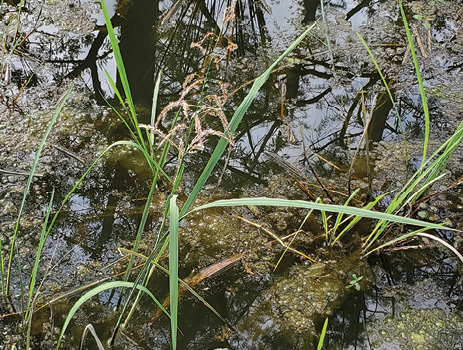Cut Grass | Leersia and Zizaniopsis spp.
Emergent | Native



Cut grass can grow along shorelines or as a floating mat in calm water. It can be problematic and is a pest in many agricultural settings.
The leaves are flat, thin, and sword-like. They are rough to the touch and have sharp edges. Stems are wire-like, often leaning, with hairy nodes where the leaves join the stem.
Flowers are located at the tip of the branch in clusters. Cut grass primarily reproduces via its creeping rhizomes, but it can reproduce by seed.
Management Value
Cut grass is a native species that can be a valuable food source for ducks and other birds. Mats may provide some cover to aquatic species. However, due to its mat-forming characteristics, this species is not recommended for introduction into water bodies of any size.
Recommended Controls
Option 1: Glyphosate (5.4-pound formulation). For each gallon of water, mix 1.0 ounce glyphosate and 1.3 ounces nonionic surfactant. Spray to wet all plants. Do not exceed annual herbicide rate limits as stated on the product label.
Option 2: Penoxsulam (2.0-pound formulation). For each gallon of water, mix 0.1 ounce penoxsulam and 1.3 ounces nonionic surfactant. Spray to wet all plants. Do not exceed annual herbicide rate limits as stated on the product label.
Option 3: Bispyribac-sodium (80 percent active). For each gallon of water, mix 0.04 ounce bispyribac-sodium (by weight) and 1.3 ounces non-ionic surfactant. Spray to wet all plants. Do not exceed annual herbicide rate limits as stated on the product label.
Bispyribac-sodium is a powdered formulation that is measured by weight rather than volume. Multiple applications may be needed to achieve eradication.
Read and follow all chemical label instructions, especially the section on the use of personal protection equipment.

The information given here is for educational purposes only. References to commercial products, trade names, or suppliers are made with the understanding that no endorsement is implied and that no discrimination against other products or suppliers is intended.
Publication 3735-23 (POD-11-23)
By Wes Neal, PhD, Extension/Research Professor, Wildlife, Fisheries, and Aquaculture; Dennis Riecke, Fisheries Coordinator, Mississippi Department of Wildlife, Fisheries, and Parks; and Gray Turnage, PhD, Assistant Research/Extension Professor, GeoSystems Research Institute.
The Mississippi State University Extension Service is working to ensure all web content is accessible to all users. If you need assistance accessing any of our content, please email the webteam or call 662-325-2262.



